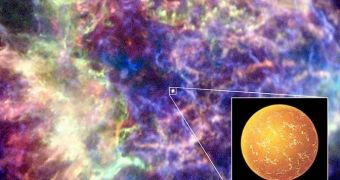The supernova remnant Cassiopeia A is, by far, one of the strangest space formations in the Milky Way. For starters, it's one of the youngest supernova remnants in the galaxy. Additionally, its structure is so peculiar that astronomers have been puzzling for a long time over what the celestial body might actually be. Finally, it appears that scientists have the answer. Astrophysicists believe that it may, in fact, be a neutron star, the densely-packed core of a collapsed star, Space reports.
The commissioning of the Chandra X-ray Observatory in 1999, was a turning point in our understanding of the peculiar space structure. Astronomers finally became able to peer into the very heart of the supernova remnant, and to determine that the neutron star at its core was found in a dense, carbon atmosphere. Based on early astronomical observations by Britain's first Astronomer Royal, John Flamsteed, Cassiopeia A is approximately 330 years old, which is very little by cosmic standards. The “official” astronomer made his observations in 1680.
But the real breakthrough in knowledge came less than a decade ago, with Chandra. “Before then it was thought there's probably going to be either a neutron star or a black hole in the center of this object, but it wasn't sure what – nobody had seen it. [Using Chandra] we were actually able to pick out something at the center,” University of Alberta in Canada expert Craig Heinke says. He is also coauthor of the new investigation. But, even up-close, Cassiopeia A still retained some of its mysteries. “The properties of this object were a little strange,” Heinke adds.
One of the main issues was the fact that the body's atmosphere was made up of carbon. That gave astronomers something to scratch their heads over. Eventually, the experts determined that the young age of the star was to blame for its peculiar behavior and atmospheric oddities. “This is the youngest neutron star that we have ever observed. The fact that this is so young means that it's been really, really hot the most recently of any neutron stars,” the expert says.
In it's earliest days, the neutron star may have also been capable of conducting “nuclear fusion on its surface, and burn the hydrogen and helium into carbon,” Heinke adds. This behavior may account for the fact that the star is only 0.1 miles (0.2 kilometers) in diameter, and that the energy it emits comes from hotspots on its surface, rather than from the entire surface.

 14 DAY TRIAL //
14 DAY TRIAL //